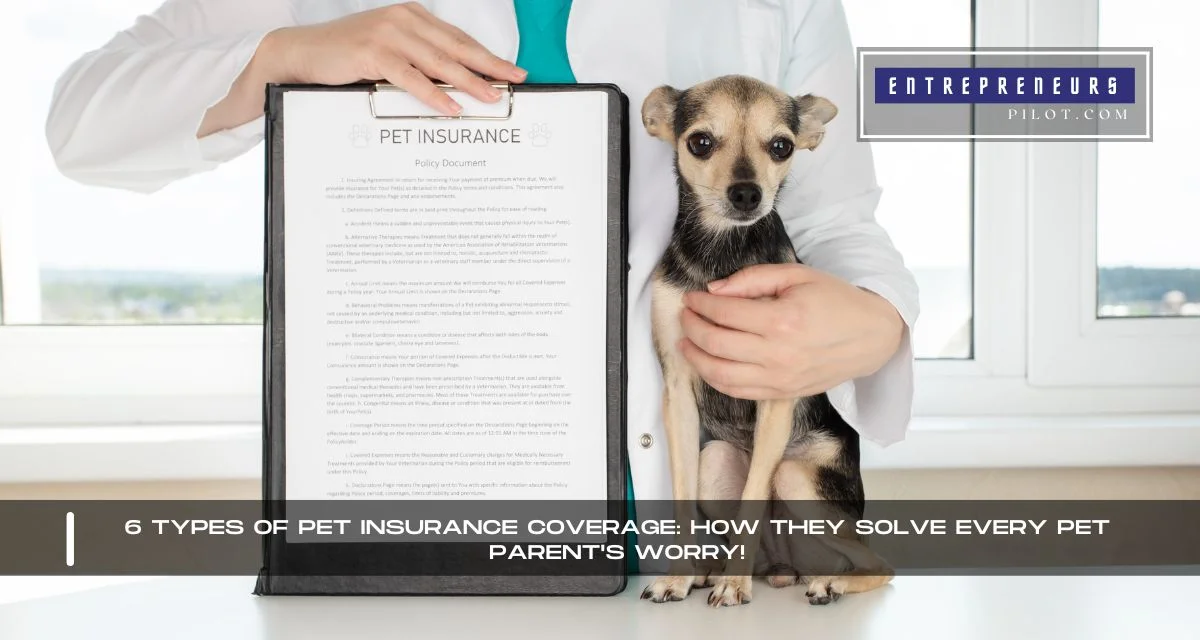Introduction
Ever find yourself awake at 3 a.m., worrying about what you’d do if your furry best friend suddenly fell ill or got injured? You’re not alone. Every pet parent’s nightmare is the unexpected vet bill that seems to come at the worst possible time. Enter the hero of our story: pet insurance. Specifically, understanding the different types of pet insurance coverage can be a game-changer for pet parents, transforming fear into peace of mind.
In this guide, we’ll dive deep into the six essential types of pet insurance coverage, unraveling how each one addresses every pet parent’s worry. From accidents to illnesses, and even routine care, there’s a plan out there that fits your pet’s needs and your budget. Let’s embark on this journey to secure a happier, healthier future for our beloved pets.
Table of Contents
1. Accident-Only Coverage
Accident-only coverage is the safety net that catches you when the unexpected happens. Think of it as the guardian angel for your pet, stepping in when they decide to eat something they shouldn’t or when an enthusiastic game of fetch ends with a limp. This type of coverage is straightforward and typically the most affordable option. It’s designed to cover the bills for emergency treatments, surgeries, and diagnostic tests following an accident. For pet parents on a budget who still want to ensure their pet’s safety, this coverage can be a lifesaver, literally.
2. Comprehensive Coverage
Comprehensive coverage is the all-inclusive resort of pet insurance. It combines accident coverage with illness coverage, offering a broad safety net that covers everything from broken bones to cancer treatments. This type of coverage is ideal for pet parents who want to prepare for every possibility. It not only handles the immediate emergencies but also the complex health issues that can arise over a pet’s lifetime. Investing in comprehensive coverage means investing in peace of mind, knowing that whether it’s an accident or a chronic condition, you’re covered.
- For Expert Financial Insights And Guidance, You Can Visit Our Sister Site – ArabsGeek.com Now!
- Curiosity Piqued? Dive Into the Most Captivating Financial Content by Visiting Our Homepage!
- Unlock Exclusive Business Opportunities! 🚀 Connect with Us Now at our Email: [email protected]!
3. Wellness and Routine Care Coverage
Wellness and routine care coverage focus on the adage that prevention is better than cure. It’s about keeping your pet healthy, rather than just treating them when they’re sick. This coverage typically includes vaccinations, annual check-ups, flea and tick prevention, and dental cleanings. It’s for the pet parents who understand that regular care can prevent bigger problems down the line. While it might seem like an added expense, this proactive approach can lead to savings by catching issues early and maintaining your pet’s overall health.
4. Illness Coverage
Illness coverage is the shield against the diseases and health conditions that can affect our pets. From minor ailments like ear infections to major concerns like kidney disease, illness coverage ensures that you’re prepared for the health challenges your pet might face. This type of coverage is particularly important as our furry friends age and become more susceptible to illness. For pet parents, it means not having to choose between financial stability and the well-being of their beloved pet.
5. Hereditary and Congenital Conditions Coverage
This coverage is a beacon of hope for owners of breeds prone to specific health issues. Hereditary and congenital conditions coverage ensures that the quirks of your pet’s genetic makeup don’t lead to insurmountable medical bills. Conditions like hip dysplasia in large breeds or heart defects in some smaller breeds can be managed, not feared, with the right insurance plan. This type of coverage allows pet parents to focus on the joy their pets bring into their lives, rather than worrying about potential genetic health issues.
6. End-of-Life Coverage
Perhaps the most delicate subject, but equally important, is end-of-life coverage. This coverage supports you during the most challenging times, covering euthanasia, cremation, or burial costs. It’s a compassionate acknowledgment that every aspect of pet ownership, including the end, should be handled with care and respect. For many pet parents, this coverage provides not only financial support but also emotional peace, knowing they can provide their pet with a dignified farewell.
Conclusion | Types Of Pet Insurance Coverage
Understanding the types of pet insurance coverage is crucial in navigating the complex world of pet health care. Each type offers a unique set of benefits designed to alleviate the worries pet parents face. Whether it’s an unexpected accident, a routine check-up, or the onset of a chronic illness, there’s coverage available to suit every need and budget. Investing in pet insurance is not just a financial decision; it’s a commitment to the health and happiness of your furry family member. By choosing the right type of coverage, you’re ensuring that your pet can enjoy a long, healthy life by your side, free from the shadow of “what if.
Frequently Asked Questions
01. What’s the best type of pet insurance coverage for a young, healthy pet?
For a young, healthy pet, a comprehensive coverage plan might seem like a lot, but it’s the best way to prepare for any unexpected health issues or accidents. However, starting with accident-only coverage and wellness and routine care can also be a smart, budget-friendly choice.
02. Can I switch between types of pet insurance coverage as my pet ages?
Yes, many insurance providers offer the flexibility to switch between plans as your pet’s needs change. However, it’s important to note that pre-existing conditions may not be covered if you switch plans or providers.
03. Are there any types of pet insurance coverage that cover pre-existing conditions?
Most pet insurance plans do not cover pre-existing conditions. However, some specific plans might offer coverage for conditions that have been cured and without symptoms for a certain period.
04. How does hereditary and congenital conditions coverage work?
This coverage is designed to insure against diseases or disorders that are inherited or present at birth. It’s crucial for breeds known to have specific health issues, but there might be waiting periods before coverage becomes effective.
05. Is end-of-life coverage included in all pet insurance plans?
Not all plans automatically include end-of-life coverage. It’s often an optional add-on or part of more comprehensive plans. It’s important to check the details of your policy to understand what end-of-life services are covered.











